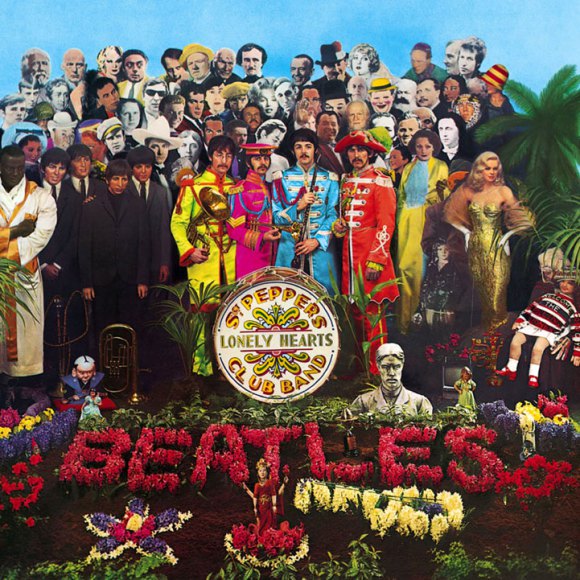The greatest album ever? The best Beatles album? Well that's all subjective, and we're all entitled to our own opinion, but in mine, it is neither. I would argue that Revolver is a better album, as is Abbey Road. But that's just my view and one thing is for sure, Sgt. Pepper is undoubtedly one of the greatest albums of all time and saw The Beatles rising to new peaks of songwriting. Sgt. Peppers blew our minds when released in June of 1967; it captured British culture, flower power and the feelings of a young and exited generation.
So, what can be said about Pepper that hasn't been said before? Lets dig deep and see if we can unearth some of the lesser-known facts that helped make-up this masterpiece.
The songs: “When I’m 64” became the first track to be recorded for the album, with the first session taking place on 6th Dec 1966. The song which was first hatched during The Beatles days in Hamburg was supposedly reworked that autumn by Paul because his father was approaching - 64.
Lennon's "Lucy in the Sky with Diamonds" was inspired by a drawing his 3 year-old son Julian returned home from school with one day. The picture, which was of a little girl with lots of stars, was his classmate - Lucy O’Donnell, who also lived in Weybridge, and attended the same school as Julian. When the album was released, both the press and fans insisted the song was instead about Lennon's many LSD trips, after all the title gave it away.
George Harrison has only one song on the album, "Within Without You", but there should have been a second. The quite one's “Only a Northern Song”, was intended for inclusion right up to the moment that McCartney decided to reprise the title track. One of Harrison’s bitterest Beatle songs, it was a dig at the band’s publishing company, and the ostensible concept (an album of ‘northern songs’) McCartney hoped to impose on the project.
The lyrics for Lennon's song "Being for the Benefit of Mr. Kite!", were inspired and re-worked from a Victorian circus poster for Pablo Fanque's circus, which Lennon had bought at an antique shop in Kent when he was taking a break from filming the promotional clip for "Strawberry Fields Forever".
And what of the closing track, "A Day in the Life". The thunderous piano chord that concludes the album, was produced by assembling three grand pianos in the studio and playing an E chord on each simultaneously. Together, John, Paul and Ringo with the help of assistant Mal Evans hammered the keys on the pianos to create the effect.
Read : The Beatles – Love Me Do
The orchestral recording sessions for "A Day in the Life", was filmed by six cameramen, the footage was planned to be used for a Sgt. Pepper television special. The idea was to included all the songs from the album set to music in video style scenes, again The Beatles were well ahead of their time, but the plans were shelved and the footage eventually surfaced in The Beatles Anthology documentary.
Another hard to believe fact is that the album was mixed in mono because very few people in 1967 had stereo record players, (stereo was strictly for hi-fi nuts) and to prove the point, none of the Beatles attended the sessions for the stereo mixes. (On certain versions of vinyl and even CD pressings, if you listen with the balance turned to just one speaker, you hear 'Pepper' like you've never heard it before, missing backing vocals, no drums and guitars missing from the mix).
You could write an article on the sleeve itself! The cover was created by Jann Haworth and Peter Blake who won the Grammy Award for Best Album Cover, in 1968. Over 60 famous figures feature on the cover, from musicians, actors, politicians and writers. A model of Jesus was planned for inclusion but didn't make it, (the LP was released only a few months after Lennon's Jesus statement, and they didn't want to stir that one up again). There are nine Beatles on the cover including ex Beatle Stuart Sutcliffe.
Read : The Beatles – Abbey Road
And what of that bit of gibberish that we all found ourselves listening to over an over again as the needle was stuck in the groove at the end of side two? (You see we miss all this fun in the digital age). According to the June 1967 Beatles Monthly, this tape-loop was ‘just a bit of jabbering conversation by the lads themselves which was speeded up. When curiosity got the better of some fans, they decided to play their LP backwards – and found it appeared to say, ‘We’ll fuck you like Superman.’
And all this magic was recorded over 129 days using 4-track recording machines. The fabs, laid down their parts on what was then becoming outdated studio equipment, (some studios in the US already had 8-track machines), guided and encouraged by the fifth Beatle, producer George Martin. New techniques were used and invented during these sessions. ADT, (automatic double tracking) was used because Lennon hated having to 'track' his vocal, (ADT then became a universal studio feature). They slowed and speeded up the tapes using varispeed to give them a thicker and unique sound.
And just to prove how prolific these Northern lads were, the first fruits of this exercise, "Penny Lane" and "Strawberry Fields Forever", didn't even make it on to the album but instead were released as the double A-sided single in February 1967 after EMI had pressured The Beatles for a single release.
There is no-other way to describe Sgt. Pepper but as a masterpiece.
Read : The Beatles – Hi Hi Hi

